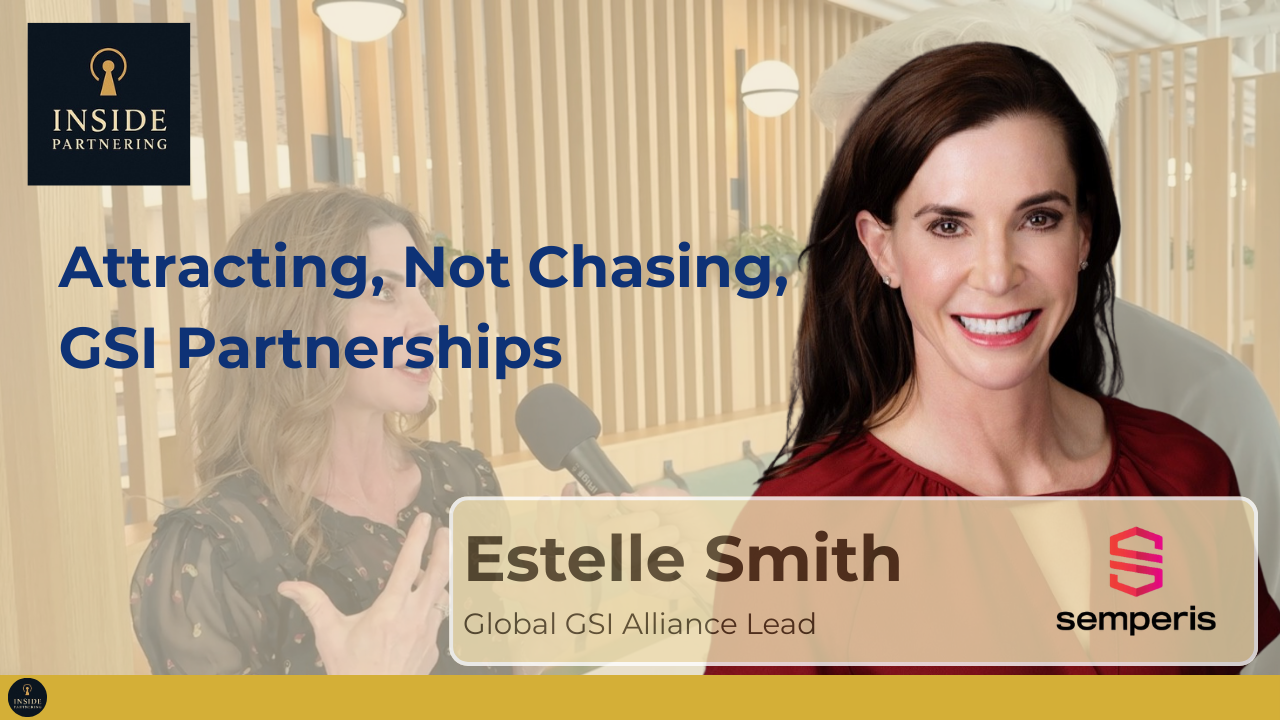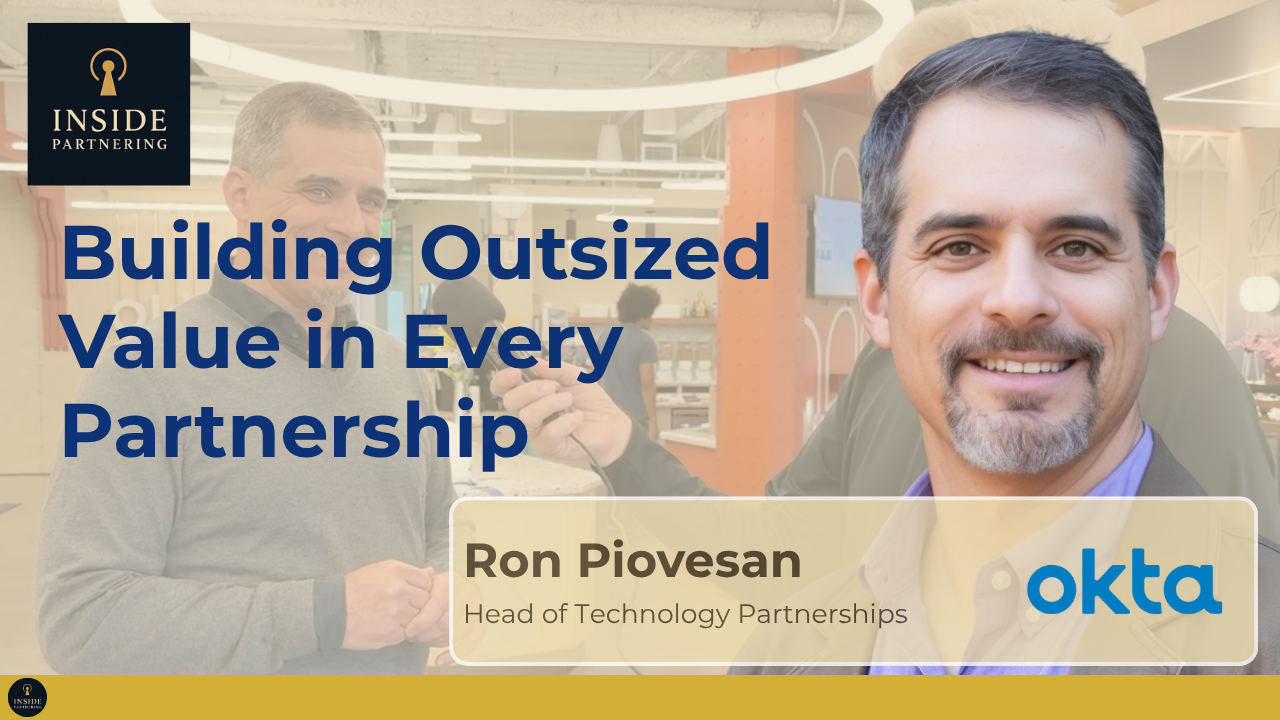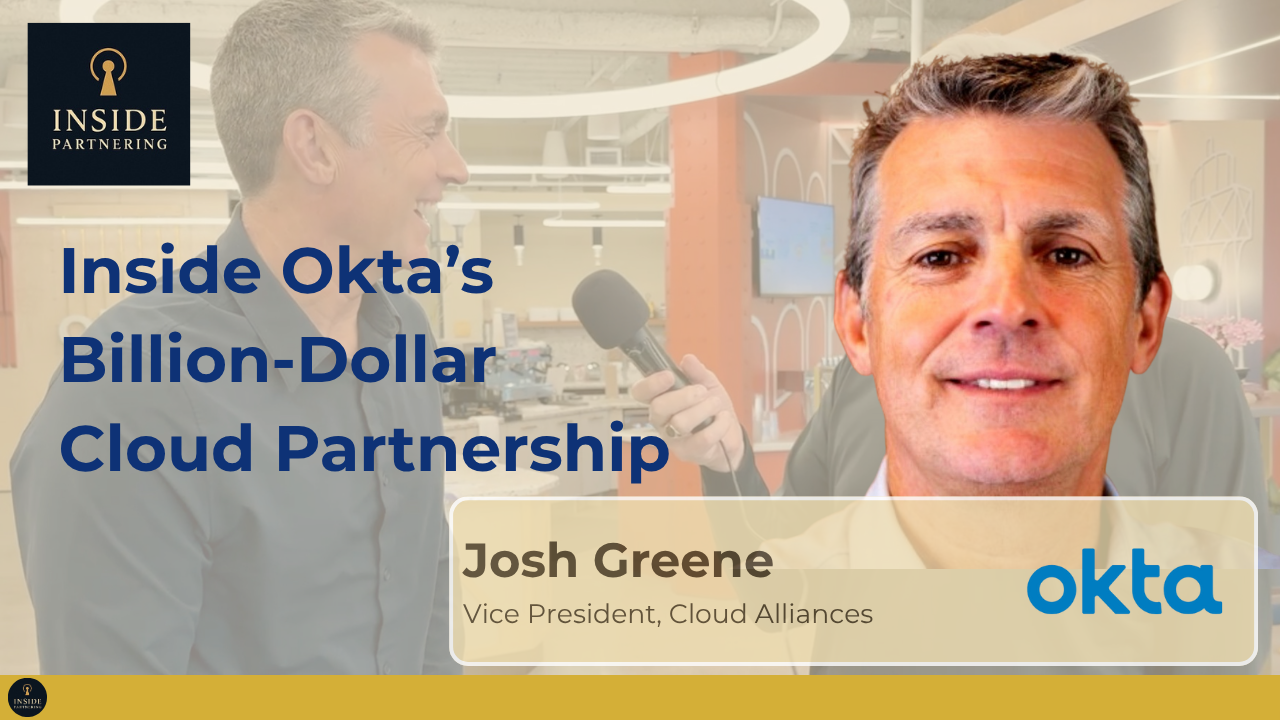Episode Overview
At the Partnership Leaders Catalyst Summit in San Francisco, I had the opportunity to sit down with Estelle Smith, Global GSI Alliance Lead at Semperis. Estelle has built a remarkable career across IBM, Oracle, Workday, and Fortanix before joining Semperis, where she is helping the company scale its global partnerships in the critical space of identity protection.
Cybersecurity is a fast-growing sector, with identity protection at the center. Nine out of ten cyberattacks target identity infrastructure. Semperis specializes in protecting and recovering identities across hybrid and multi-cloud environments, and their go-to-market approach is striking: 100% partner-led.
Why Partner-Led Matters
Estelle explained that for Semperis to succeed, they need to be the “easy button” for their partners. That means enabling GSIs and MSPs with training, certifications, and a clear partner program. It also means aligning with how partners go to market - whether as resellers, managed service providers, or solution influencers.
The company takes a twofold approach:
- Top-down: building a global program that adapts to regional nuances.
- Bottom-up: driving account-level engagement and winning a few key deals to build momentum.
This balance allows Semperis to build credibility, prove value, and attract the attention of large GSIs by showing demonstrated success.
Focus Over Frenzy
One of Estelle’s guiding principles is focus. Instead of chasing dozens of partners, Semperis invests in a small subset of GSIs. By starting with two or three wins and broadcasting that success across the partner’s organization, they create a flywheel effect that scales influence and trust.
She also highlighted the importance of regional systems integrators (SIs). These “sharks and minnows,” as she described them, can be nimble and effective early partners. By proving success with regional players, Semperis develops playbooks and case studies that make it easier to engage larger GSIs later.
Measuring Success
Partnerships thrive when success is measurable. For Estelle, that includes tracking:
- Partner-sourced opportunities
- Partner-influenced deals
- Renewal rates
- Customer-driven pull from GSIs
“You can’t manage what you can’t measure,” Estelle said, underscoring the importance of data to validate strategy and demonstrate ROI.
Why GSIs Want to Work with Semperis
Three factors make Semperis especially attractive to partners:
- Market Growth: Cybersecurity is growing at double digits annually.
- Enterprise Customers: Semperis already has large customers in place.
- Product Fit: Their solutions protect the most targeted area of enterprise infrastructure - identity.
As Estelle put it, the combination of growth, proof, and alignment makes GSIs want to lean in rather than be chased.
Lessons for Partner Leaders
Estelle’s story offers valuable lessons for anyone building strategic alliances:
- Stay partner-led by design, not by accident.
- Balance global strategy with local execution.
- Focus on fewer, deeper relationships rather than spreading thin.
- Celebrate and amplify early wins to build credibility.
- Measure and communicate impact relentlessly.
- Leave a comment
Semperis’ journey demonstrates that when a company commits fully to its partners, it creates a multiplier effect that drives growth for everyone involved.
This episode is a must-listen for partner leaders navigating complex ecosystems, especially in fast-moving industries like cybersecurity.
Podcast
Guest

Estelle Smith
Strategic and partnership-driven, I specialize in building high-impact alliances with hyperscalers, GSI/MSP, and emerging tech partners to drive innovation and business transformation. With deep expertise in cloud security, Confidential AI, and GTM strategy, I focus on scaling joint solutions that deliver measurable outcomes. I bring a consulting mindset, execution rigor, and talent for enabling ecosystem-led growth, translating complex technologies into strategic value for customers and partners alike.
Episode Transcript
Estelle Smith
===
[00:00:00] Estelle Smith: that's a challenge, right? But it's also an opportunity. So can we get two to three wins and then start to highlight that out through their organizations, and then start to identify new opportunities to start to get that flywheel going and that multiplier going.
[00:00:20] Chip Rodgers: Hey everyone, Chip Rodgers here again for another terrific episode and conversation today with Estelle Smith and Estelle. Welcome.
[00:00:29] Estelle Smith: Thank you. Nice to be here with you.
[00:00:31] Chip Rodgers: Yeah, so we're here in San Francisco at the Asana headquarters. We found a quiet corner here, upstairs 'cause some of the, one of the sessions is going on and we just wanted to, didn't want to interrupt anybody, but what a great event.
[00:00:44] Chip Rodgers: I think a couple hundred folks here for the Partnership Leaders Catalyst Summit here in San Francisco.
[00:00:52] Estelle Smith: Yeah, it's great. And we've had great speakers. Talking a lot about what we are seeing in the market, what we see across the [00:01:00] landscape, the partner ecosystem, what works, what are our challenges, and so it's nice to get together and discuss these.
[00:01:07] Estelle Smith: Yeah.
[00:01:08] Chip Rodgers: Yeah. Some really good content, interesting findings and challenges. Shared challenges. Some of it's just hearing the, the pain that other people are experiencing, the same kind of pain that you are. Right?
[00:01:19] Estelle Smith: Yeah. It's nice to hear that you're not alone out there.
[00:01:21] Chip Rodgers: So I'm like I said, I'm really excited to have Estelle join us.
[00:01:24] Chip Rodgers: And Estelle is Global GSI Alliance's Lead for Semperis. And you've been in that role for not quite a year, eight, nine months, almost a year. I just made my six month mark. Terrific. Yeah. Prior to that, Fortanix Fortanix, sorry. And, gosh, you've made the, you've made the circuit with IBM and Oracle and Workday, right?
[00:01:48] Chip Rodgers: Workday. Workday, yeah. So it's been nice
[00:01:50] Estelle Smith: to work across from large enterprise to emerging technologies and working across partner ecosystems with hyperscalers, with [00:02:00] ai, and now really focusing in on cybersecurity.
[00:02:04] Chip Rodgers: Yeah. Yeah. And GSIs, yes. Yeah. GSIs. Yeah. Which is really interesting.
[00:02:08] Chip Rodgers: So I want to, let's start there. Why don't, let me just ask you to tell a little bit more about what it is that your role is and how you're, what are you, what are your goals with Semperis?
[00:02:19] Estelle Smith: Yeah, so Semperis is a cybersecurity company and we specialize in protecting and recovering identities in hybrid and multi-cloud.
[00:02:31] Estelle Smith: And when you think about threat. About 90% are going to be within that identity infrastructure. And my task is really how do we get service partners and manage service partners to collaborate with our solutions. And since this is a large area, we have a product fit within the market, we do get working with our GSIs fairly well.
[00:02:55] Estelle Smith: So I have, my approach is twofold, which is a. Top down approach, which is [00:03:00] how do we build a global program that we can execute regionally across the world, taking in the nuances of working in different regions and then also bottoms up, right? So it's how do we get that exposure, our unfair share of attention from these GSIs and service partners at the account level?
[00:03:21] Chip Rodgers: And that's globally, right? Yeah. So wrong.
[00:03:24] Estelle Smith: Yeah.
[00:03:24] Chip Rodgers: Yeah. I think one of the things that's interesting about how Semperis, goes to market is you are 100% partner led,
[00:03:33] Estelle Smith: right? I think sometimes you, to be a great partner, you have to be the easy button, and we've made our program 100% partner led, so there's an incentive there.
[00:03:42] Estelle Smith: Another thing that we also do is that we make sure that we have information, we have influence, what we do is we make sure that we educate and enable our partners. We do the same internally, and we understand what does a win look like between both [00:04:00] organizations.
[00:04:00] Chip Rodgers: And what does it look like? What is a win? What's the winning sort of formula for Semperis working with a partner, A GSI partner.
[00:04:09] Estelle Smith: Yeah. To be able for, to be a strategic partner. For a service partner, there is usually a dollar value that they're looking at to have from service offerings.
[00:04:19] Estelle Smith: And so what we do is we work closely with our GSI partners that we're able to identify accounts. And they're either the reseller or what they could also be is a solution influencer, so that whenever they may own the relationship and in some cases they actually may be our partner, our, sorry, our customers, so that they are managing the data infrastructure and the cyber resiliency for that custom.
[00:04:49] Estelle Smith: Customer. So we wanna make sure that on either a company's worst day or if they're having some type of crisis, incident, or crisis management [00:05:00] that they remember and call Semperis.
[00:05:02] Chip Rodgers: How do you, how are you able to do a hundred percent, partner led is it is, so all of your, basically, do you have a direct.
[00:05:12] Chip Rodgers: Sales team.
[00:05:13] Estelle Smith: We do have a direct sales team, and this is a top down approach. So our C-suite. Our executives are all on board for it to be partner led. So we have a great program in place. We have a partner program in place. We're actually getting ready to roll out new training and certifications, which I'm super excited about.
[00:05:33] Estelle Smith: And so we really, whenever we're having conversations or onboarding new partners, it's one thing that we do in emphasize, which is working, collaborative with us, how to engage with us, how to register deals through our partner PO Partner program. And really understanding the nuances and the details around how the deals are structured.
[00:05:55] Chip Rodgers: So you mentioned that you're just rolling out a new enablement [00:06:00] program, training program, certification program. Tell us a little bit more about, about that.
[00:06:06] Estelle Smith: Yeah, so one of the areas that we really need to make sure that we're doing is. Educating our partners on the value that we bring, not only to them, but also to the customers.
[00:06:16] Estelle Smith: And so as our products start to mature and we bring new products online, like our new Ready One Crisis Management Solution, we wanna ensure that we're educating our partners. And part of it is our sales training that they understand the business value that we're bringing to partners and then the customers, sorry, and then also the technical training so that they're able to take our solutions and also go and either manage 'em or in some cases deploy them.
[00:06:49] Chip Rodgers: So it sounds like those would be two or three different audiences for those kinds of training, right? You might have a client partner that would be more on the business side, and maybe there's [00:07:00] some technical folks that are more on the, on the technology, training on it, on technology and how to do the integration and things like that.
[00:07:07] Chip Rodgers: Is that,
[00:07:08] Estelle Smith: so there may be partners that are resellers. Our distributors. And so we wanna make sure that they understand how to engage with us from a sales perspective. And then we also have partners that are service partners and they may be MSPs and so they may be managing the software solution.
[00:07:27] Estelle Smith: And so we wanna ensure that they understand and be able to tech to articulate the technical nuances of our solutions. And then after the sale. Making sure that they are utilizing them effectively.
[00:07:42] Chip Rodgers: So for MSPs that, so you're, you wanna make sure that the MSPs are fully on board up to speed on how, so that they're managing, they're providing the best Semperis service to your joint customer.
[00:07:56] Estelle Smith: Yeah, a hundred percent. Our MSP program is evolving and [00:08:00] it is maturing and it's a fairly new program that we have in place. And so we've had some wins with our MSPs. And so now what we're doing is how do we take those wins and scale with that? That's that bottoms up approach, which is we've had some wins across some accounts.
[00:08:17] Estelle Smith: How do we start to articulate that and communicate that across the MSP organizations? Start to get that within the regional presidents and regional leads and then. Start to get that at that global level, which is the solutions offering level. These GSIs and MSPs are, they're large and they're complex, and so we need to ensure that we are working with them the way that they're typically used to go into market.
[00:08:44] Estelle Smith: And that's that top down piece of it. So it's getting a delicate and a balanced approach to both sort of ways that we are going to market with them. Yeah.
[00:08:55] Chip Rodgers: Yeah. So let's talk about GSIs. That's your [00:09:00] tell me about, how are you working with GSIs? Are you co-selling with with them?
[00:09:05] Chip Rodgers: Are you going to doing co-marketing going to market together in that way?
[00:09:08] Estelle Smith: Yeah, that's a great question. So there are several different steps that we are with different GSIs. We have some that are resellers, and we also have managed service agreements with, and then we have some that we just have partnering agreements with that they're doing the service, they're advising, they're influencing the solutions.
[00:09:29] Estelle Smith: And then we work with them on this, on the sales side of the house. One thing that I've ensured that we start with is attracting the right partners versus chasing too many partners. And you've heard this today, which is trying to be too many things and do too many. Different things. Also focusing in, so we've identified a key small subset of focus partners.
[00:09:55] Estelle Smith: So focus GSIs that we're investing in and [00:10:00] starting to go to market with, do enablement with. Can we do account alignment with them? How do we educate throughout their organization to start to get that flywheel going? If we, that's a challenge, right? But it's also an opportunity. So can we get two to three wins and then start to highlight that out through their organizations, and then start to identify new opportunities to start to get that flywheel going and that multiplier going.
[00:10:29] Estelle Smith: Yeah.
[00:10:30] Chip Rodgers: Yeah. Not easy.
[00:10:32] Estelle Smith: No, it's not easy. But we wouldn't be here if you were easy, right? That's right.
[00:10:37] Chip Rodgers: So that's great. That's that's fantastic. So how are you how are, how is the partner organization and how are partners measured against those goals?
[00:10:48] Estelle Smith: Yeah, so we have a program that you've heard a lot about today, which is around partner sourced and partner influence.
[00:10:55] Estelle Smith: And we also have a referral a partnership. So one of the, one of the new. [00:11:00] The ideas is that as we grow and evolve as a partnership, we need to make sure that we are measuring the right metrics. How many partner source, how many inbounds are we having versus outbounds, right? Making sure that we're capturing that in our systems.
[00:11:16] Estelle Smith: You can't manage what you can't measure. So one of the, one of the challenges that we're doing is making sure that we're capturing that data. And being able to use it, what does our renewal rate look like? That's another measurement that we also start to look at.
[00:11:30] Chip Rodgers: Yeah. I think renewals are really important for partners as well, right?
[00:11:33] Chip Rodgers: Because they're very much embedded with the customer. And so if the customer's happy, which is part product and part. The services that are being delivered, then that, that's a win.
[00:11:45] Estelle Smith: Yeah. I think also one of our largest achievement is our customer base, which is a customer, a service partner coming to us and saying, I need to learn more about you because your customer says that you're [00:12:00] using Semperis, are that they have recently purchased Semperis and they want to make that, part of the service offering that they are.
[00:12:07] Estelle Smith: The GSI is offering to them. And so that, that's a big testament. That is one of the reasons why some of the GSIs are coming to us. So it's that premise of I'm attracting versus I'm chasing GSIs and starting with one to two or three of them and really making this a wind is. Is going to get the other ones involved because there could be some scarcity after that coming on board.
[00:12:33] Estelle Smith: Another Chip, another strategy that I'm using is looking at regional SIs and starting with them. There's, if you think about the large GSIs of the world being the whales and then, you can think about a regional SI being either a shark that's, can easily evolve or a minnow, which is fast and nimble.
[00:12:55] Estelle Smith: Starting and starting to build out that framework with a smaller [00:13:00] GSI or a regional I, sorry, with a regional SI. And building not only the framework, but getting the playbooks in place, getting the wins in the belt, then you're able to take that and leverage that as you start to grow as an organization.
[00:13:14] Estelle Smith: So where we are today is not where we're going to be three years from now, but we'll wanna ensure that we're showing value now. And as we project that value out three years from now.
[00:13:25] Chip Rodgers: Yeah. And being a hundred percent, partner led, it's, that's a lot to, be able to, to have that as the goal.
[00:13:35] Chip Rodgers: And then really, making the solution and the capabilities and the partnership attractive to bring those partners in to hit that goal. , what are the things that you're doing that are, do make Semperis really attractive to GSIs?
[00:13:51] Chip Rodgers: 'cause you've been successful. So what, how, what are you doing?
[00:13:54] Estelle Smith: There's a couple. Ways that we are being attracted to or [00:14:00] remaining attractive to GSIs. One is the cybersecurity space. It is a space that's growing about 13%. And so service partners are starting to make investments reorganizations within their organization within this space.
[00:14:16] Estelle Smith: Another one is around having large enterprise customers. And then also having a product fit. And so since 90, so
[00:14:27] Chip Rodgers: you're already in that space, GSIs matching to large enterprise customers. You've got the use cases, you've got the case stories to be able to tell the story.
[00:14:37] Estelle Smith: Yeah, absolutely. So we're starting to get interest from more GSIs because of their alignment within this space.
[00:14:47] Estelle Smith: And we have a product fit. So when you think about. Nine out of 10 bad actors are gonna go after the identity infrastructure at our company. Since we protect that space, we are an attractive [00:15:00] product and have a product fit within the market. Yeah,
[00:15:04] Chip Rodgers: and you're already doing it and you have other GSIs that are already have been successful as well.
[00:15:12] Estelle Smith: They have been successful and in some cases they're also customers of ours. Yeah,
[00:15:17] Chip Rodgers: that's great. Estelle, this has been fantastic. Thank you so much for sharing your experiences with Semperis and the programs that you're running and how you're working with GSI Partners and others. We talked about MSBs and the technology and this has been fantastic.
[00:15:33] Estelle Smith: Thank you so much, Chip. It's been a pleasure.
[00:15:35] Chip Rodgers: That's awesome. So thank you Estelle, and thank you all for joining another episode of Inside Partnering and we'll see you next time. Thanks everybody.
[00:16:00]

Chip Rodgers
🚀 CMO | Chief Partner Officer | B2B SaaS Growth & GTM Leader | Ecosystem Strategy | Demand Gen | Podcast Host 🎙




